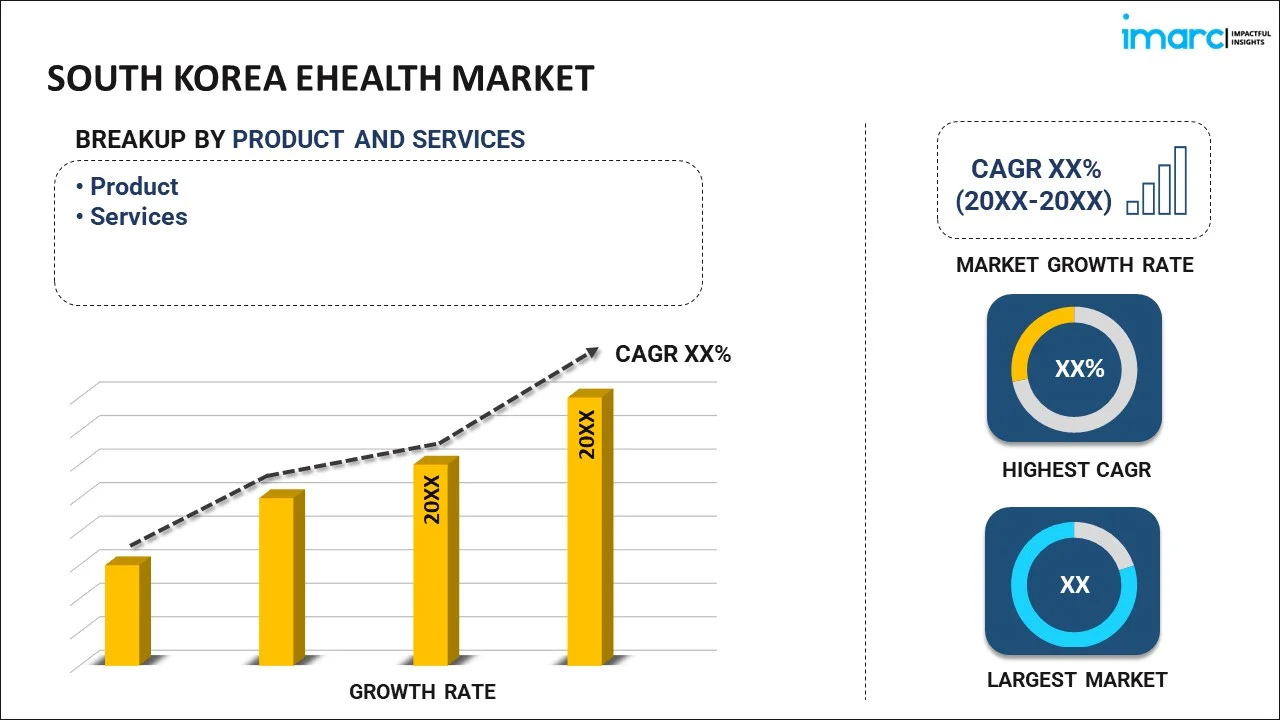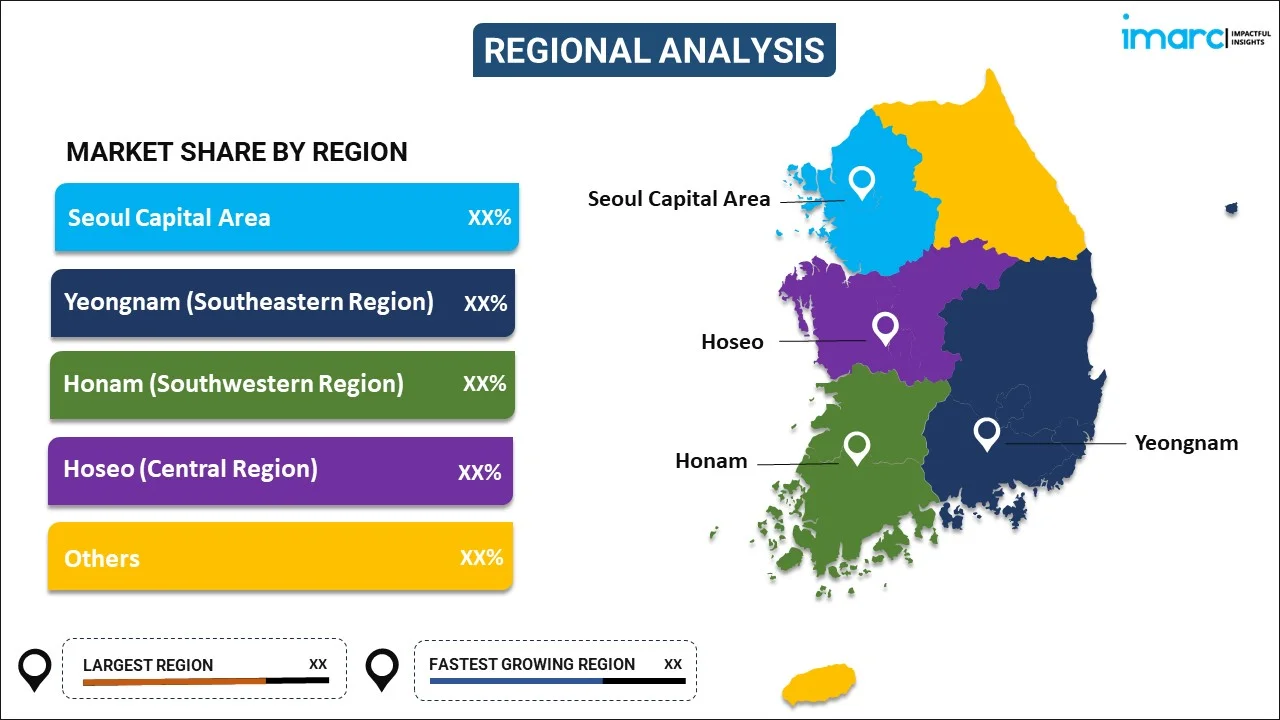
South Korea eHealth Market Report by Product and Services (Product, Services), End User (Healthcare Providers, Payers, Healthcare Consumers, and Others), and Region 2025-2033
Market Overview:
South Korea eHealth market size reached USD 2.7 Billion in 2024. Looking forward, IMARC Group expects the market to reach USD 10.1 Billion by 2033, exhibiting a growth rate (CAGR) of 14.2% during 2025-2033. The increasing demand for interoperability and seamless data exchange between different healthcare systems and providers that enables a comprehensive view of patient information, leading to better-informed decision-making, is driving the market.
|
Report Attribute
|
Key Statistics
|
|---|---|
|
Base Year
|
2024 |
|
Forecast Years
|
2025-2033 |
|
Historical Years
|
2019-2024
|
| Market Size in 2024 | USD 2.7 Billion |
| Market Forecast in 2033 | USD 10.1 Billion |
| Market Growth Rate (2025-2033) | 14.2% |
eHealth, short for electronic health, refers to the integration of digital technologies in the healthcare sector to enhance the delivery of medical services, improve patient care, and streamline healthcare processes. It encompasses a broad range of applications, including electronic health records (EHRs), telemedicine, health information exchange, and mobile health solutions. EHRs enable the digitization of patient information, making it easily accessible to healthcare providers, promoting efficient communication, and reducing errors. Telemedicine facilitates remote consultations and monitoring, increasing access to healthcare services and bridging geographical gaps. Health information exchange allows the secure sharing of patient data among different healthcare entities, promoting coordinated and collaborative care. Mobile health leverages smartphones and wearable devices to empower individuals in managing their health, from monitoring vital signs to accessing health-related information and interventions. eHealth plays a pivotal role in modernizing healthcare, promoting data-driven decision-making, and ultimately contributing to improved patient outcomes and healthcare system efficiency.
South Korea eHealth Market Trends:
The eHealth market in South Korea is experiencing rapid growth, driven by several key factors. Firstly, the increasing prevalence of chronic diseases necessitates advanced healthcare solutions, propelling the demand for eHealth technologies. Moreover, the ubiquitous adoption of smartphones and wearable devices has created a conducive environment for remote patient monitoring, telemedicine, and other eHealth services. Additionally, the ongoing regional digitization of healthcare records and the push towards interoperability contribute to the expansion of the eHealth market. Furthermore, the accelerated acceptance of virtual healthcare, which fosters a paradigm shift towards telehealth services and digital health tools, is also augmenting the market growth. Consequently, the integration of artificial intelligence and machine learning in healthcare analytics is becoming pivotal, enhancing diagnostic capabilities and personalized treatment plans. In summary, the confluence of these factors establishes a compelling narrative for the sustained growth and evolution of the eHealth market in South Korea, reshaping the landscape of modern healthcare delivery.
South Korea eHealth Market Segmentation:
IMARC Group provides an analysis of the key trends in each segment of the market, along with forecasts at the country level for 2025-2033. Our report has categorized the market based on product and services and end user.
Product and Services Insights:

- Product
- Electronic Health Records
- ePrescribing
- Clinical Decision Support
- Telemedicine
- Consumer Health Information
- mHealth
- Others
- Services
- Monitoring
- Diagnostic
- Healthcare Strengthening
- Others
The report has provided a detailed breakup and analysis of the market based on the product and services. This includes product (electronic health records, eprescribing, clinical decision support, telemedicine, consumer health information, mhealth, and others) and services (monitoring, diagnostic, healthcare strengthening, and others).
End User Insights:
- Healthcare Providers
- Payers
- Healthcare Consumers
- Others
A detailed breakup and analysis of the market based on the end user have also been provided in the report. This includes healthcare providers, payers, healthcare consumers, and others.
Regional Insights:

- Seoul Capital Area
- Yeongnam (Southeastern Region)
- Honam (Southwestern Region)
- Hoseo (Central Region)
- Others
The report has also provided a comprehensive analysis of all the major regional markets, which include Seoul Capital Area, Yeongnam (Southeastern Region), Honam (Southwestern Region), Hoseo (Central Region), and Others.
Competitive Landscape:
The market research report has also provided a comprehensive analysis of the competitive landscape in the market. Competitive analysis such as market structure, key player positioning, top winning strategies, competitive dashboard, and company evaluation quadrant has been covered in the report. Also, detailed profiles of all major companies have been provided.
South Korea eHealth Market Report Coverage:
| Report Features | Details |
|---|---|
| Base Year of the Analysis | 2024 |
| Historical Period | 2019-2024 |
| Forecast Period | 2025-2033 |
| Units | Billion USD |
| Scope of the Report | Exploration of Historical Trends and Market Outlook, Industry Catalysts and Challenges, Segment-Wise Historical and Future Market Assessment:
|
| Product and Services Covered |
|
| End Users Covered | Healthcare Providers, Payers, Healthcare Consumers, Others |
| Regions Covered | Seoul Capital Area, Yeongnam (Southeastern Region), Honam (Southwestern Region), Hoseo (Central Region), Others |
| Customization Scope | 10% Free Customization |
| Post-Sale Analyst Support | 10-12 Weeks |
| Delivery Format | PDF and Excel through Email (We can also provide the editable version of the report in PPT/Word format on special request) |
Key Questions Answered in This Report:
- How has the South Korea eHealth market performed so far and how will it perform in the coming years?
- What has been the impact of COVID-19 on the South Korea eHealth market?
- What is the breakup of the South Korea eHealth market on the basis of product and services?
- What is the breakup of the South Korea eHealth market on the basis of end user?
- What are the various stages in the value chain of the South Korea eHealth market?
- What are the key driving factors and challenges in the South Korea eHealth?
- What is the structure of the South Korea eHealth market and who are the key players?
- What is the degree of competition in the South Korea eHealth market?
Key Benefits for Stakeholders:
- IMARC’s industry report offers a comprehensive quantitative analysis of various market segments, historical and current market trends, market forecasts, and dynamics of the South Korea eHealth market from 2019-2033.
- The research report provides the latest information on the market drivers, challenges, and opportunities in the South Korea eHealth market.
- Porter's five forces analysis assist stakeholders in assessing the impact of new entrants, competitive rivalry, supplier power, buyer power, and the threat of substitution. It helps stakeholders to analyze the level of competition within the South Korea eHealth industry and its attractiveness.
- Competitive landscape allows stakeholders to understand their competitive environment and provides an insight into the current positions of key players in the market.
Need more help?
- Speak to our experienced analysts for insights on the current market scenarios.
- Include additional segments and countries to customize the report as per your requirement.
- Gain an unparalleled competitive advantage in your domain by understanding how to utilize the report and positively impacting your operations and revenue.
- For further assistance, please connect with our analysts.
 Inquire Before Buying
Inquire Before Buying
 Speak to an Analyst
Speak to an Analyst
 Request Brochure
Request Brochure
 Request Customization
Request Customization




.webp)




.webp)












